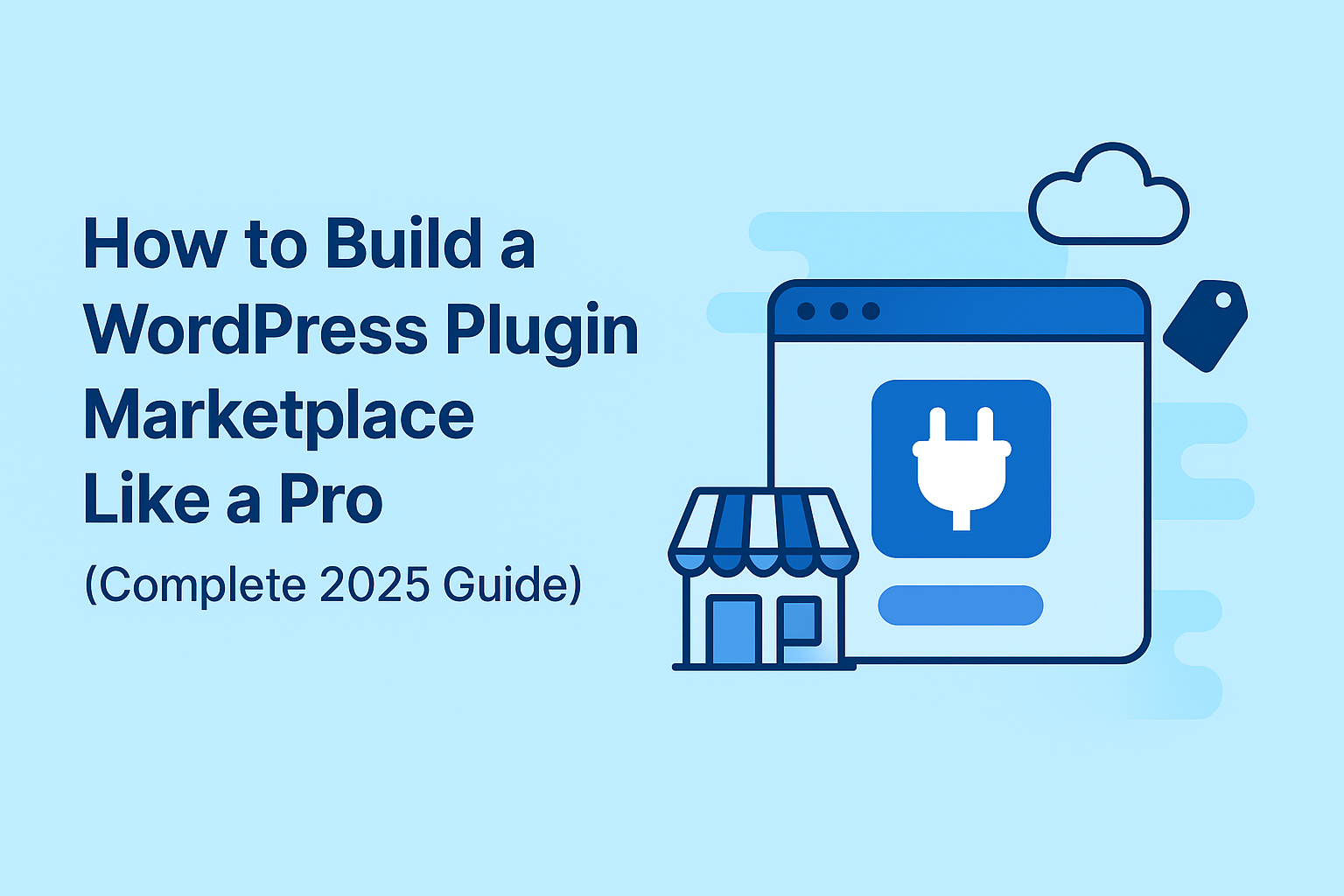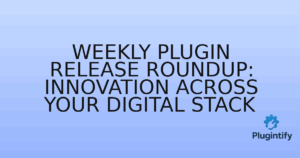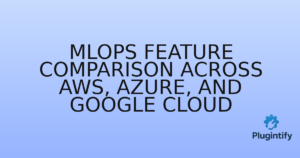How to Build a WordPress Plugin Marketplace Like a Pro (Complete 2025 Guide)
Introduction
Launching a plugin marketplace is a high-leverage way to serve the WordPress ecosystem, capture recurring revenue, and create a hub for quality plugins. This guide walks you through business strategy, technical architecture, payments, licensing & update flows, moderation, legal considerations, growth tactics, and a practical launch checklist — everything you need to build a professional marketplace in 2025.
1 — Choose your marketplace model & niche
- Curated marketplace — higher trust, slower growth, better quality (ideal for premium plugins).
- Open marketplace — faster onboarding, requires robust moderation and automated scans.
- Hybrid — open submissions with a curated “featured” section.
Pick a niche (SEO plugins, membership plugins, eCommerce extensions, Gutenberg blocks) to reduce early friction and attract target buyers/developers.
2 — Core product & UX features
Your MVP should include:
- Publisher onboarding & dashboard (upload packages, changelogs, versions)
- Plugin listing pages (screenshots, descriptions, changelog, demo link)
- Search, categories, tags, and filters (compatibility, PHP version, WordPress version)
- Secure file storage & CDN for downloads
- Payments & subscriptions (Stripe / Paddle / Lemon Squeezy)
- Licensing server & automatic update API
- Ratings, reviews, and support threads
- Admin moderation console + automated security scans
3 — Recommended tech stack (scalable & maintainable)
- Frontend: Next.js (React) or Nuxt (Vue) for SEO + SSR
- Backend: Laravel or Node.js (Nest/Express) — API-first
- Database: PostgreSQL (recommended) or MySQL
- File storage: AWS S3 / Cloudflare R2 + CDN (CloudFront / Bunny / Cloudflare)
- Search: ElasticSearch / MeiliSearch / Typesense for fast plugin discovery
- Auth: OAuth2 / JWT; social logins optional
- Payments: Stripe Connect (marketplace payouts) or Paddle (VAT & compliance)
- Containerization & infra: Docker, Kubernetes or managed services (DigitalOcean App Platform, AWS ECS/EKS)
- CI/CD: GitHub Actions + Terraform / Pulumi for infra as code
4 — Licensing & automatic updates (critical)
Implement a reliable licensing & updates flow — this is central to marketplace trust and recurring revenue.
- When a purchase completes, generate a unique license key (tied to email, site URL, plan).
- Create an update-check endpoint — `GET /api/update-check?slug=plugin-slug&license=KEY` — returns latest version metadata and signed download URL if license valid.
- Provide a lightweight client library (PHP) plugin authors include to validate licenses and register update hooks (HMAC or JWT signed responses recommended).
- Support site activation limits, site migration, and license transfer flows in the developer dashboard.
5 — Payments, fees & payouts
Payment choices affect taxes, compliance and your operational overhead:
- Stripe Connect — flexible, supports marketplace payouts, KYC required for connected accounts.
- Paddle — handles VAT, sales tax and checkout, simpler for global sellers but less direct control.
- Lemon Squeezy — alternative with subscriptions & license support built-in.
Decide your revenue model: commission (e.g., 20–30%), listing fees, or subscription tiers for developers (featured listings, analytics). Make fees transparent in the seller agreement.
6 — Security, malware scanning & moderation
Security is a must — compromised plugins harm users and your reputation.
- Integrate automated static analysis (PHPStan), dependency scanning (Snyk) and malware scanners on upload.
- Run sandboxed dynamic analysis (execute on ephemeral containers) to detect malicious behavior.
- Require authors to provide documentation, code headers, and a vendor contact.
- Human review for paid/premium listings or first-time authors.
- Fast takedown process and clear DMCA / abuse flow.
7 — Developer experience & onboarding
Attract quality plugins with a smooth onboarding flow:
- Clear submission guidelines, code standards and security requirements.
- CLI or GitHub integration: allow authors to publish via GitHub Releases or a CLI that uploads signed packages.
- Developer dashboard: analytics (downloads, active installs), payout history, license management.
- Docs & SDKs: client libraries for licensing, update-checks, and sample templates.
8 — Marketplace UX & SEO
- Unique, detailed plugin pages (H1, features, screenshots, changelog, FAQ).
- Structured data (JSON-LD) for each plugin: `SoftwareApplication` + reviews & rating markup.
- Category pages with rich content and internal linking for SEO.
- Fast search with faceted filters (compatibility, pricing model, rating).
9 — Legal & compliance
Get legal right from day one:
- Terms of Service and Privacy Policy (GDPR & CCPA-ready).
- Seller agreement: revenue share, IP, permitted content, liability limits.
- Refund & dispute policy and a clear SLA for premium plugins.
- Tax handling & VAT rules — use Paddle if you want this handled for you or integrate tax calculations.
10 — Growth & go-to-market strategies
- Invite-only launch: onboard 10–30 high-quality plugins before public launch.
- Partnerships: co-marketing with plugin authors and agencies.
- Content & SEO: tutorials, plugin comparisons, case studies.
- Affiliate program: incentivize bloggers and agencies to promote listings.
- Bundles & promotions: seasonal deals, developer spotlights, curated bundles.
11 — Metrics to track
- Conversion rate (visitor → purchase)
- Active licenses / active installs
- Average revenue per developer / per buyer
- Churn & refund rates
- Developer retention & new plugin velocity
12 — Scaling & operations
Design for scale early:
- Use CDN for downloads and static assets to reduce origin load.
- Cache license checks with short TTL to reduce DB pressure, but provide immediate revocation flows.
- Rate-limit API endpoints and implement robust monitoring (Prometheus, Grafana, Sentry).
- Automate backups, DB migrations and blue/green deployments for safe updates.
13 — Sample architecture (high-level)
[User Browser] <- HTTPS -> [Frontend (Next.js)] <- REST/GraphQL -> [API Gateway]
|
[Backend API (Laravel / Node)]
/ | \
[DB: Postgres] [Storage: S3] [License Server]
| |
[CDN: CloudFront / Bunny]
14 — Launch checklist (MVP)
- Core listing & search — done
- Developer onboarding & upload flow — done
- Payment & checkout (+ VAT flow) — done
- License generation & update API — done
- CDN + secure file hosting — done
- Automated security scans & moderation UI — configured
- SEO-optimized pages + structured data — published
- Analytics & monitoring — configured
- Legal docs & seller agreement — published
15 — Pricing strategies
Consider multiple revenue channels:
- Commission on sales (industry standard 20–30%)
- Developer subscription for premium benefits (featured placement, analytics)
- Listing fees for enterprise or white-label listings
- Marketplace-run promotions and bundles with revenue share splits
16 — Handling refunds & disputes
Define a clear refunds policy: technical refunds for broken plugins, trial periods, and mediation process. Keep vendor and buyer protection balanced — this preserves trust.
17 — Long-term ops: trust & community
Invest in community: forums, Slack/Discord groups, regular audits and feature requests. A trusted marketplace is a sticky marketplace.
Conclusion
Building a professional WordPress plugin marketplace requires product judgment, secure engineering, clear legal frameworks, and an aggressive go-to-market plan. Start focused, automate what you can, and prioritize trust — security, reliable updates, and strong developer experience will set your marketplace apart.
Useful Links & Resources
- WordPress Plugin Developer Handbook
- Stripe Connect (marketplaces)
- Paddle — payments & tax
- Snyk — dependency & vulnerability scanning
Published by Plugintify — The Hub for WordPress Plugin Developers.




